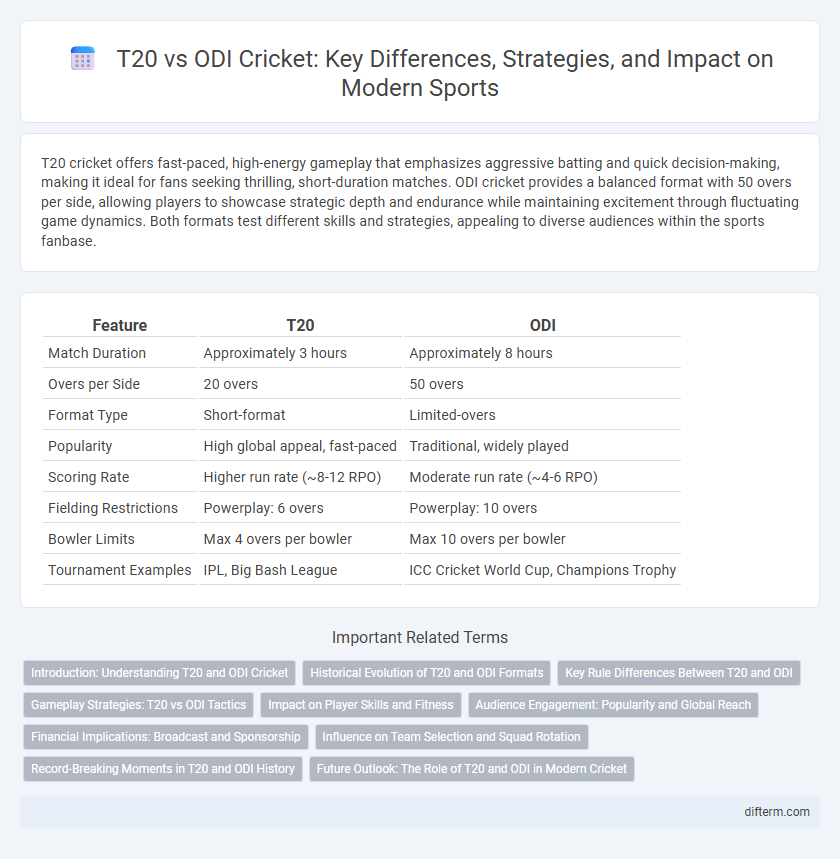T20 cricket offers fast-paced, high-energy gameplay that emphasizes aggressive batting and quick decision-making, making it ideal for fans seeking thrilling, short-duration matches. ODI cricket provides a balanced format with 50 overs per side, allowing players to showcase strategic depth and endurance while maintaining excitement through fluctuating game dynamics. Both formats test different skills and strategies, appealing to diverse audiences within the sports fanbase.
Table of Comparison
| Feature | T20 | ODI |
|---|---|---|
| Match Duration | Approximately 3 hours | Approximately 8 hours |
| Overs per Side | 20 overs | 50 overs |
| Format Type | Short-format | Limited-overs |
| Popularity | High global appeal, fast-paced | Traditional, widely played |
| Scoring Rate | Higher run rate (~8-12 RPO) | Moderate run rate (~4-6 RPO) |
| Fielding Restrictions | Powerplay: 6 overs | Powerplay: 10 overs |
| Bowler Limits | Max 4 overs per bowler | Max 10 overs per bowler |
| Tournament Examples | IPL, Big Bash League | ICC Cricket World Cup, Champions Trophy |
Introduction: Understanding T20 and ODI Cricket
T20 cricket features a fast-paced format with 20 overs per side, designed to deliver high-intensity action within approximately three hours, emphasizing aggressive batting and dynamic strategies. ODI cricket consists of 50 overs per side, blending endurance and tactical play over a full day, allowing for more nuanced innings-building and varied bowling plans. Both formats demand unique skill sets, shaping team composition, player roles, and fan experiences distinctively.
Historical Evolution of T20 and ODI Formats
The ODI format, introduced in 1971, revolutionized cricket by offering a 50-over per side match that combined traditional test skills with faster scoring rates, leading to widespread popularity and the first Cricket World Cup in 1975. T20 cricket emerged in 2003 as a shorter, more dynamic 20-over format designed to attract a broader audience and provide fast-paced entertainment, resulting in global leagues like the IPL that transformed player roles and strategies. Both formats have evolved through technological advancements and rule changes, shaping modern cricket's competitive landscape and fan engagement.
Key Rule Differences Between T20 and ODI
T20 cricket features 20 overs per side, creating a fast-paced game with a maximum of 4 overs per bowler, whereas ODI cricket consists of 50 overs per side with a limit of 10 overs per bowler. Fielding restrictions differ, with T20 enforcing powerplay overs that last only 6 overs, compared to 10 overs in ODIs. The result is distinct strategic approaches affecting batting tempo, bowling variation, and field placements in each format.
Gameplay Strategies: T20 vs ODI Tactics
T20 cricket demands aggressive gameplay with batsmen prioritizing high strike rates to maximize runs within 20 overs, emphasizing power-hitting and innovative shots from the start. ODI strategies balance aggression and restraint over 50 overs, focusing on building innings through steady partnerships and rotating the strike to preserve wickets. Bowling tactics in T20 revolve around variation and containment to restrict scoring, whereas ODI bowlers employ a mix of pace and spin to exploit batsmen's patience over longer spells.
Impact on Player Skills and Fitness
T20 cricket demands explosive power, quick reflexes, and adaptability due to its fast pace and shorter duration, leading players to develop enhanced batting aggression and specialized bowling variations. ODI format requires greater endurance, strategic pacing, and versatile skillsets as players balance stamina with consistency over 50 overs. The distinct physical and mental challenges in both formats drive tailored fitness regimes, influencing how cricketers condition themselves for agility, strength, and recovery.
Audience Engagement: Popularity and Global Reach
T20 cricket captivates global audiences with its fast-paced, high-intensity matches typically lasting around three hours, making it highly accessible for viewers seeking thrilling entertainment. The format's explosion in popularity, driven by events like the Indian Premier League (IPL) and Big Bash League (BBL), has expanded cricket's global reach to non-traditional markets, boosting fan engagement through social media and digital platforms. In contrast, ODIs maintain strong viewership among traditional cricket fans due to their balanced format of 50 overs per side, offering a more strategic and extended playing experience that continues to draw loyal international audiences.
Financial Implications: Broadcast and Sponsorship
T20 cricket generates significantly higher broadcast revenues due to its shorter duration attracting larger live and digital audiences, leading to premium advertising slots. Sponsorship deals for T20 leagues command greater investment as brands seek immediate global exposure and association with fast-paced entertainment. In contrast, ODI formats, with longer match times, offer steady but typically lower financial returns from broadcasters and sponsors focused on traditional cricket viewership.
Influence on Team Selection and Squad Rotation
T20 cricket's fast-paced nature demands teams prioritize players with explosive power-hitting and specialized death-over bowling, influencing squad rotation to optimize match-specific strategies. In contrast, ODI formats require balanced all-rounders and consistent performers to sustain longer innings and adapt to varying match situations, affecting team selection toward stamina and versatility. Coaches often rotate players between formats to maintain fitness levels and exploit specific skill sets suited to either the 20-over or 50-over gameplay.
Record-Breaking Moments in T20 and ODI History
T20 cricket witnessed record-breaking moments such as the fastest century by Chris Gayle in just 30 balls, showcasing explosive batting prowess. In ODI history, Sachin Tendulkar's record of 49 centuries remains unparalleled, highlighting consistency and endurance. Both formats have redefined batting strategies, with T20 emphasizing rapid scoring and ODIs balancing aggression with resilience.
Future Outlook: The Role of T20 and ODI in Modern Cricket
T20 cricket continues to revolutionize the sport with its fast-paced entertainment and global appeal, attracting younger audiences and expanding market opportunities through leagues like the IPL and Big Bash. Meanwhile, ODI cricket maintains its strategic depth and tradition, serving as a critical pathway for international rankings and World Cup competitions. The future of modern cricket lies in balancing T20's dynamic growth with the enduring prestige of ODIs, ensuring both formats evolve to meet fan engagement and commercial demands.
T20 vs ODI (cricket formats) Infographic

 difterm.com
difterm.com